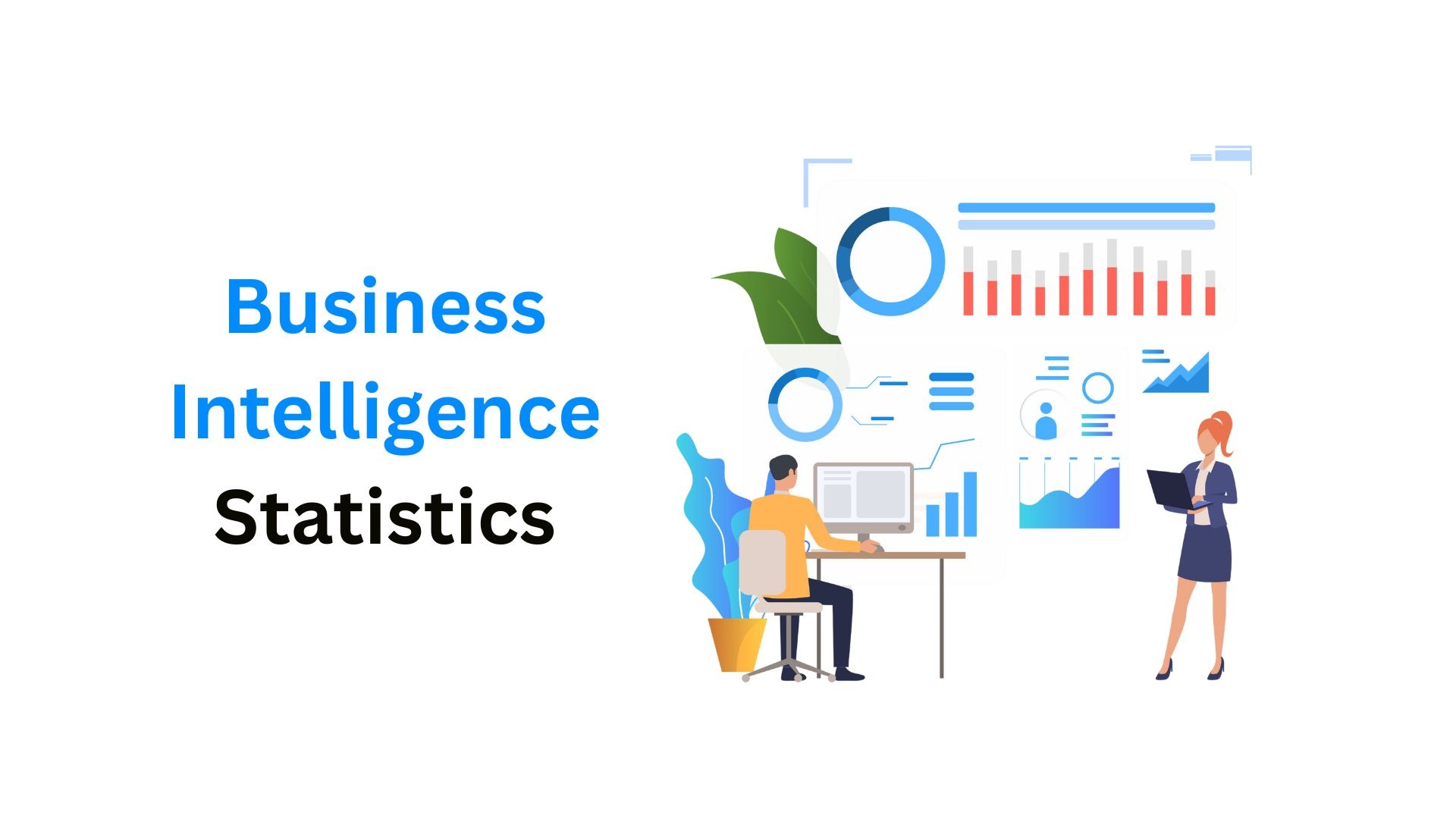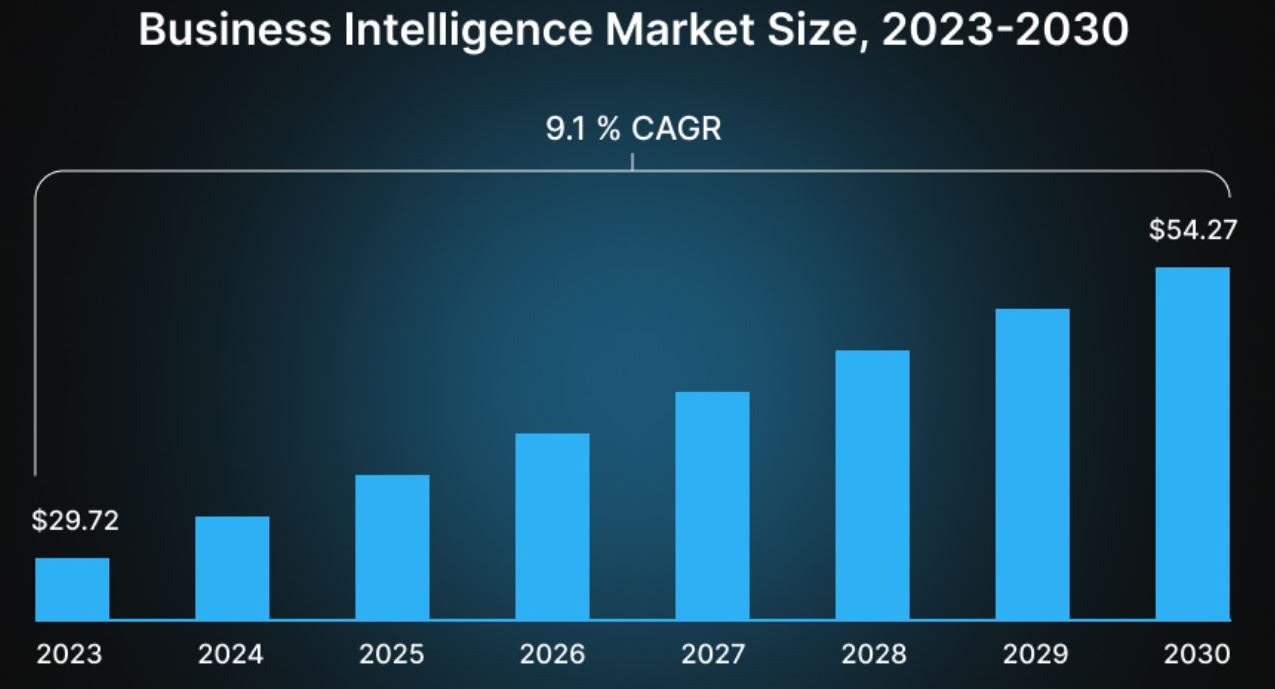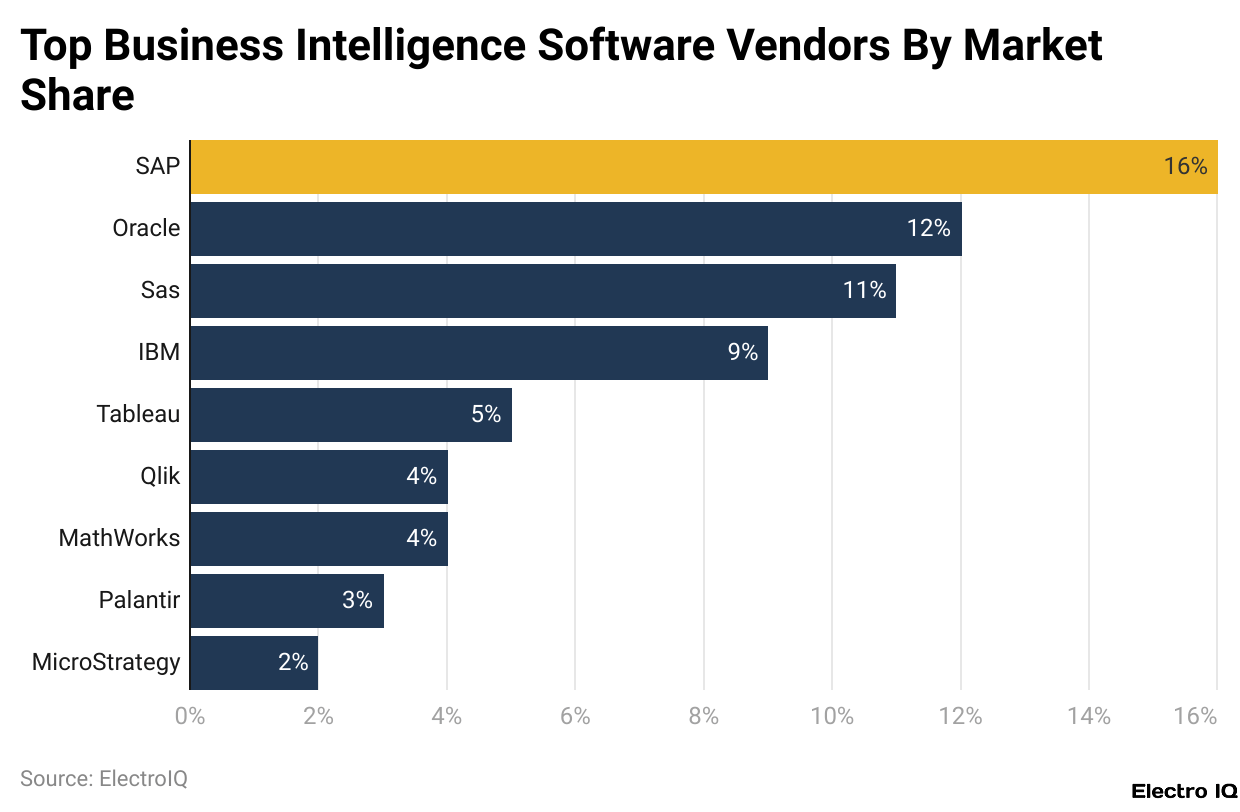Business Intelligence Statistics By Market, Job And Usage Trends (2025)
Updated · Sep 08, 2025

Table of Contents
- Introduction
- Editor’s Choice
- Business Intelligence Market Size
- Business Intelligence Statistics Across Sectors And Industries
- Importance of Data Visualisation In Business Intelligence
- Business Intelligence Job Statistics
- Business Intelligence Software Vendors By Market Share
- Business Intelligence Usage Trends
- Cloud-Based Business Intelligence Statistics
- Conclusion
Introduction
Business Intelligence Statistics: Business Intelligence (BI) is a set of processes, technologies, and tools that are used to collect data and convert it into valuable business information. Such information is crucial for making strategic decisions. In 2024, we are seeing a surge in BI adoption across all company sizes, with more powerful tools than ever before. The companies that implement BI software are better informed about business trends, have improved operational efficiency, and have increased profitability.
This article will collect the most recent data regarding Business Intelligence statistics and financial information about the 2024 BI software market and discuss the explosive growth of this market and the reasons behind it.
Editor’s Choice
- The global BI market was US$29.42 billion in 2023 and is projected to hit US$54.27 billion by 2030 at a 9.1% CAGR.
- The worldwide BI platform market could reach US$45.2 billion by 2030.
- The BI software segment alone is expected to expand to US$42.99 billion by 2030 with a 9.02% CAGR (2024–2030).
- Mobile BI is projected to reach US$51.5 billion by 2032, sustained by a 15.3% CAGR (2024–2032).
- The BI and analytics software applications market is expected to be worth US$18 billion by 2026.
- Companies spend US$7.80 per employee on average on BI software.
- 49% of companies increased BI usage post-pandemic.
- The healthcare BI market alone is expected to reach US$25.86 billion by 2032. As for the executives, 86% of them believe social media is crucial for their strategy.
- The percentage of executives who regard social media data as an important BI data source is 93%.
- By 2025, SR Analytics predicts 75% of data stories will be generated automatically.
- The growth of the BI analysts’ job market is anticipated to be 20% from 2024 to 2030, with 284,100 new jobs being added.
- 32% of people feel confident enough to use data effectively, and only 24% of executives have data literacy certification.
- Nine vendors hold 66% of the BI software market, generating US$14.9 billion in revenue.
- 16% of the share goes to SAP, 12% to Oracle, and 11% to SAS. 67% of the global workforce has access to BI tools, with adoption being the highest in manufacturing, business services, and financial services.
- At a CAGR of 22.8%, the cloud-based BI market is expected to be worth US$15.2 billion by 2026.
Business Intelligence Market Size

(Source: pixelplex.io)
- Multiple research documents have highlighted the strong growth of the business intelligence (BI) market.
- Per Fortune Business Insights, the global BI market was estimated to be worth US$29.42 billion in 2023, which is expected to grow to US$54.27 billion by 2030 at a CAGR of 9.1%.
- Globally, the BI platform market is projected to reach US$45.2 billion by 2030, with the business intelligence software segment alone growing to US$42.99 billion by 2030, at a CAGR of 9.02% from 2024 to 2030, according to a RationalStat report on Business Intelligence statistics.
- From 2024 to 2032, mobile BI is predicted to grow at an impressive CAGR of 15.3%, reaching a market size of US$51.5 billion in 2032.
- According to Statista, BI and analytics software applications are expected to exceed US$18 billion by 2026.
- In terms of adoption, in 2023, roughly one-third of large companies had decision intelligence-capable analysts.
- Market segmentation indicates that cloud-based BI outperforms web-based BI, and large companies use BI significantly more than SMEs.
- The market structure includes various tool categories—dashboards, scorecards, OLAP and visualisation tools, predictive analytics, and query and reporting tools, as per the Skyquest BI report.
- Statista expects that by 2025, the average employee expenditure on BI software will be US$7.80.
- The impact of BI on decision-making is unquestionable.
- Companies whose CEOs make decisions based on data are 77% more likely to outperform their competitors, as concluded in a Deloitte study.
- The benefits of big data and business analytics have greatly increased the need for BI platforms.
- They are currently being shaped by major players such as IBM, Oracle, Microsoft, SAP, and Google.
- In surveys regarding use-case tools, Sisense has found that 49% of companies are using BI tools more than they did before the pandemic.
- Infosys has reported that BI platforms are the third most favoured technology, as only 20% of companies choose it compared to cloud technology (23%) and digital trust (22%).
- Market Research Future also states that BI on the cloud is the fastest-growing segment, which further underlines the global inclination towards solutions that are more flexible and scalable.
Business Intelligence Statistics Across Sectors And Industries
- Business intelligence is being applied in many different industries, where it is being leveraged to address challenges specific to each sector and improve productivity.
- For instance, the projected US$25.86 billion value of the global BI market in healthcare by 2032 underscores the critical role of analytics in enhancing patient care and hospital management.
- According to Fortune Business Insights on Business Intelligence statistics, the IT and telecommunications sectors accounted for the largest revenue share in 2022.
- Nonetheless, the BFSI, retail, manufacturing, and healthcare sectors are also investing heavily in BI.
- The fintech sector is also growing rapidly, with the global business analytics market being projected to reach US$22.9 billion by 2031.
- Social data is growing in importance in decision-making, with 86% of respondents agreeing that social media is central to business strategy and 93% stating that social media data is the crucial future source of BI insights.
- Retailers are exhibiting similar strengths: 63% of them are set to increase BI and analytics expenditures, whereas 35% of them aim to increase funding for AI development and solutions.
- About advanced features like perspective building, Salesforce research, and integrated surveys, industries like healthcare, education, and IT, as reported by Future Market Insights, expect BI platforms to enhance those features.
- The retail analytics market is forecasted to hit US$34.52 billion by 2031, which accentuates the role of BI in understanding customer behaviour and optimising sales.
- In logistics, BI gives an overview of operations in the moment, allowing for disruptions to be predicted and customer experiences to be improved.
- The use of BI in Geico helped with the efficiency of recruitment by 15%, showcasing the benefits in human resources in other businesses.
- In addition, according to the Mordor Intelligence’s HR Analytics report, BI tools alleviate the burden on analysts, enhance data security, and decrease the time needed to perform support functions.
- The financial strategy and performance management function is becoming the leading business intelligence sector and, according to Fortune Business Insights, is dominating others.
- Taking all these sectors into account, the influence of BI is unmistakable: it enhances business functions to be more data-driven, effective, and prepared for what lies ahead.
Importance of Data Visualisation In Business Intelligence
- The role of data visualisation has become increasingly vital in the area of business intelligence.
- As indicated by Tableau, 70% of businesses have expressed that data visualisation will be important to the success of business intelligence by 2025.
- The main reason for this is the fact that the human brain is able to interpret data in a visual format, such as charts, graphs, and dashboards, 60,000 times faster when compared to plain text.
- The majority of institutions have shifted their focus towards accessibility. Close to 67% now focus on self-service business intelligence tools that feature advanced data visualisation.
- This guarantees that qualitative information is disseminated throughout the entire organisation as opposed to being limited to a certain group of people.
- It is projected that 75% of data stories will be generated automatically by 2025 (SR Analytics).
- Data storytelling is the integration of visuals and explanatory narratives, rendering analytics more accessible and easier to act upon.
- Utilising this methodology allows organisations to diminish time devoted to meetings by 30%, as teams are not required to analyse raw numbers and can make strategic decisions instead.
- As noted by Yellowfin, modern BI platforms are providing businesses with a multitude of choices, with over 50 different types of visualisations available by default.
- Such helps teams to create dashboards that are appropriate for the particular needs of sales, marketing, HR, or operations departments.
- This makes certain that information is displayed with the utmost clarity and is most effectively engaging.
Business Intelligence Job Statistics
- As more attention is given to effective utilisation of data, the employment opportunities for business intelligence specialists are growing, alongside other data-related fields.
- The number of BI analyst jobs is predicted to increase by 20% between 2024 and 2030, illustrating a high need for their expertise.
- It is estimated that, in the next 10 years, roughly 284,100 new BI analyst roles will be created in the United States, which already employs 118,223 BI analysts.
- In a given organisation, nearly 25% of business intelligence users have advanced skills and, as such, demand more powerful tools to solve intricate problems, which shows the level of sophistication of BI in our real world.
- The spending of US$7.80 in 2024 per employee on BI software is a clear indicator of the focus on such tools.
- It was found that by 2023, 33% of large enterprises had already equipped their analysts with knowledge on decision intelligence.
- Decision intelligence is a subset of BI, which stands for business intelligence, and caters to advanced and automated decision-making through analytics.
- Leaders continue to show notable gaps in data skills, even with this progress.
- In the world today, only 24% of executives have valid data literacy certifications, and a mere 32% believe they have the data skills to make informed decisions.
- On the other hand, the wages for BI professionals have grown 10% in the last five years, indicating that there is an increasing demand for such skills and expertise.

(Reference: truelist.co)
- The BI software market is dominated by a few key players.
- Nine companies hold a 66% share of the market and made approximately US$14.9 billion in revenue.
- Moreover, going back to 2019, the BI and analytics software market was led by SAP with 16% market share, followed by Oracle with 12% and SAS with 11%.
- This again reiterates the presence of a few dominant players in the market.
Business Intelligence Usage Trends
- The adoption of business intelligence tools for enhanced decision-making and the attainment of business intelligence and competitive advantages is now witnessed in literally every sector of business.
- Today, on a global scale, approximately 67% of the working population has business intelligence tools at their disposal, which is a testimony to the pervasiveness of such tools.
- The increase in adoption is especially prominent in finance, business services, and manufacturing, while industries such as logistics, finance, and healthcare are in greater need of such business intelligence tools to resolve their operational and data usage issues.
- 25% of organisations engage 10 or more business intelligence platforms.
- 61% engage at least 4, and 86% engage 2 or more, showing a consistent increase and a clear preference to use more than one platform in order to satisfy their multifaceted business requirements.
- Despite this, the global BI adoption rate stands at 26%, and 4% of organisations say that they are facing difficulties in the complete adoption of BI.
- Regarding business intelligence adoption in various industries, 52% of software companies adopt the use of BI tools, and 90% of the R&D departments operate under the paradigm of BI being indispensable for innovation going forward.
- Manufacturers see the largest improvement, with 80% of companies reporting an improvement when applying BI analytics.
- Technology trends continue to influence the deployment of BI.
- BI on the cloud takes centre stage as it offers greater accessibility at a new level of scalability.
- Large enterprises, especially those with more than 10,000 employees, prefer collaborative BI that enables cooperation among different units.
- Moreover, embedded BI is gaining attention—43% of companies say it plays an important role, and 17% consider it critical, in integrating insights directly into business applications.
Cloud-Based Business Intelligence Statistics
- This area continues to rapidly grow and is expected to reach US$15.2 billion by 2026, achieving an impressive CAGR of 22.8% between 2021 and 2026.
- By 2020, approximately 59% of organisations were already using cloud-based BI platforms for data analysis and reporting, a figure predicted by BARC Research.
- Traditional on-premise solutions usually take 12 to 18 months to be operational, while cloud-based platforms stand a good chance of being deployed in 3 to 4 months.
- Dresner Advisory Services indicates that 80% of organisations using cloud BI have stated that supporting additional users and larger data volumes is more effective.
- Compared to on-premise systems, cloud solutions tend to have lower maintenance and initial costs, which is appealing to companies of any scale.
- MicroStrategy’s research indicated that 88% of companies using cloud-based BI enjoyed enhanced freedom to access and analyse data at any location and at any time.
- A large part of this increase is due to the adoption of the Software-as-a-Service (SaaS) models, which comprised the largest portion of the market in 2020 and continue to propel cloud-based BI adoption.
Conclusion
Business Intelligence Statistics: Business Intelligence (BI) is an essential tool in modern enterprises, helping companies to operate, innovate, and maintain a competitive advantage. The rapid expansion of mobile BI, cloud adoption, and advanced visualisation tools has made data not only more accessible but also more actionable. BI tools are being integrated in a multitude of sectors such as healthcare, retail, and even finance to streamline operations, enable smarter decision-making, and enhance customer satisfaction.
Additionally, the expanding employment opportunities for BI analysts further indicate the growing need for qualified personnel. The future of BI is in democratised, data-driven decision-making that is accessible to businesses of every scale.
FAQ.
According to Fortune Business Insights, the global business intelligence market was worth US$29.42 billion in 2023 and is expected to grow to US$54.27 billion by 2030, growing at a CAGR of 9.1%. Other reports project the global BI platform market to US$45.2 billion, while the BI software market could go as high as US$42.99 billion during the same period. Mobile BI is one of the fastest-growing sub-segments, projected to reach US$51.5 billion by 2032 at a CAGR of 15.3%.
The adoption of BI spans across all industries. Healthcare is estimated to have a US$25.86 billion BI market by 2032, based on patient outcomes and operational efficiency. The IT and telecommunications industries currently hold the largest revenue share, with BFSI, retail, manufacturing, and logistics also making significant investments. Retail is expected to reach US$34.52 billion in analytics by 2031, driven by a focus on understanding customers and optimising sales.
Data visualisation is increasingly recognised as a critical factor in business intelligence (BI). By 2025, 70% of organisations expect it will be necessary for BI success (Tableau). As the human brain can process images 60,000 times faster than text, visuals such as graphs and dashboards enable teams to assess situations faster and more precisely and act on them more quickly. The availability of self-service BI software is also expanding, with 67% of organisations focusing on platforms that enable non-technical staff to perform data analysis unaided.
There is a rapidly increasing demand for professionals in the field of Business Intelligence. The number of jobs for analysts in the field of Business Intelligence is forecasted to increase by 20% from 2024 to 2030, with approximately 284,100 new positions being created throughout the next decade. At present, the United States has an active workforce of 118,223 Business Intelligence analysts. Wages in the Business Intelligence sector increased by 10% during the last five years, suggesting the growing importance of these competencies.
Cloud-based BI is the fastest-growing sector of the BI industry. It is estimated to be worth US$15.2 billion by the year 2026, while maintaining a 22.8% CAGR. Cloud platforms stand out due to their speedier deployment of 3–4 months as compared to 12–18 months for on-premise solutions, as well as their enhanced scalability—80% of organisations have seen an improvement in their ability to process bigger data quantities.

I hold an MBA in Finance and Marketing, bringing a unique blend of business acumen and creative communication skills. With experience as a content in crafting statistical and research-backed content across multiple domains, including education, technology, product reviews, and company website analytics, I specialize in producing engaging, informative, and SEO-optimized content tailored to diverse audiences. My work bridges technical accuracy with compelling storytelling, helping brands educate, inform, and connect with their target markets.










